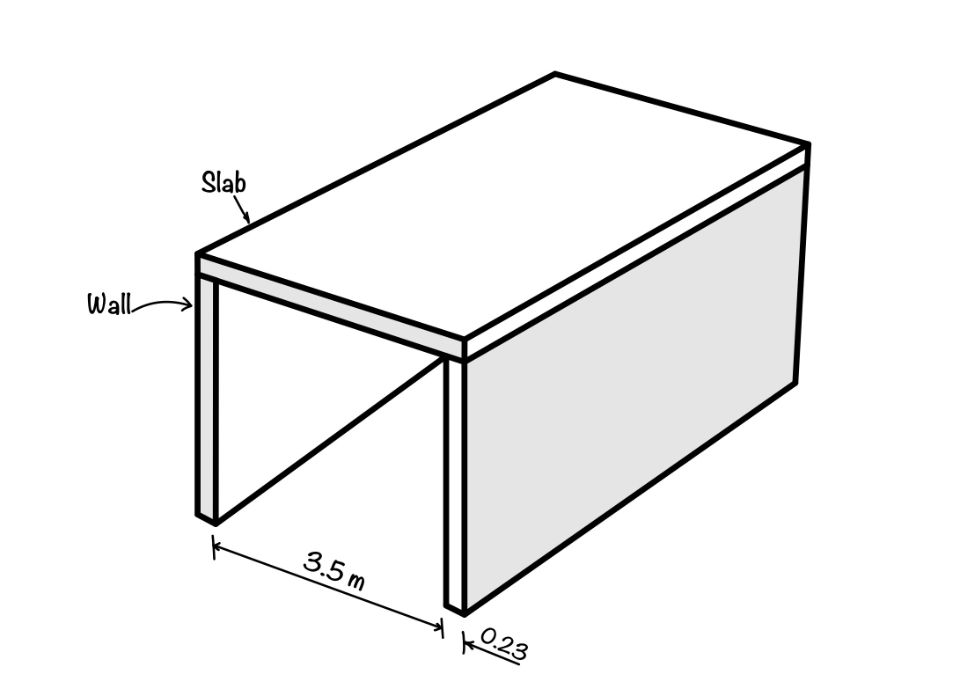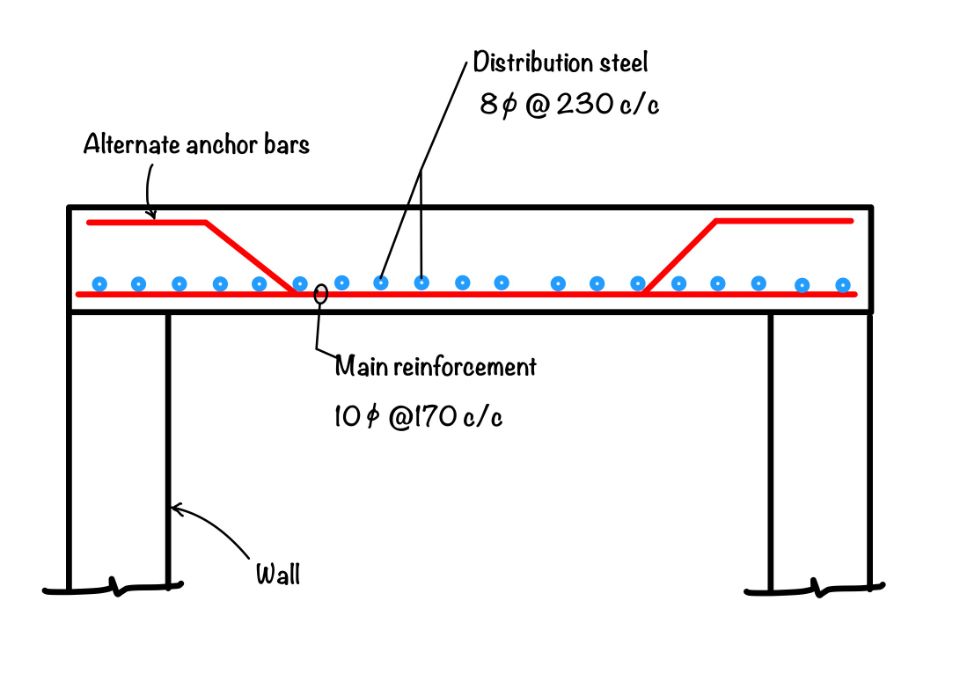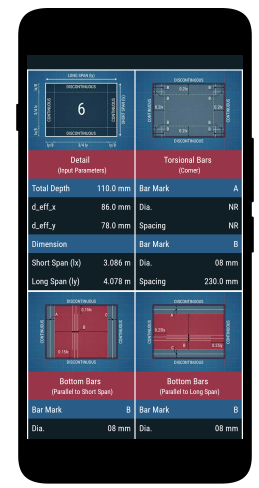One-way slabs are crucial in structural egg., serving as essential components in building and infrastructure construction. Their primary function is to transfer loads from the superstructure to the supporting elements efficiently, ensuring overall stability and safety. Understanding the design procedure for one-way slabs is crucial, especially as per IS 456: 2000, the Indian design code. This understanding enables them to create structurally sound and economically viable solutions while adhering to the prescribed standards and regulations.
We will walk through the detailed design process of a simply supported one-way slab with specific parameters.
The slab has a clear span of 3.5 m and is subjected to a live load of 3.5 kN/m2 and a floor load of 1.5 kN/m2. The supporting wall has a width of 0.23 m. For our design calculations, we will assume M20 concrete and Fe415 steel, commonly used materials in construction.

Check this post to learn the detailed step by step procedure of one way slab.
1. Trail depth and effective span
Assuming approx. depth; $$d= \frac{L}{20}$$
$$ d = \frac{3500}{20} $$
$$ d = 175 mm $$
Let’s assume D = 180 mm and cover = 20 mm for mild exposure condition.
$$ d = 180 – 20 – 10/2 $$
$$ d = 155 mm $$
So, lets take the depth as 180 mm = 0.180 m
Now effective span is taken as lesser of two ;
$$L = 3. 5 + 0.23 = 3.73 m $$ or $$ L = 3.5 + 0.155 = 3.655 m$$
So, take effective span as 3.655 m
2. Calculation of Loads
Consider the various loads due to
- Self weight: Self load refers to the weight of the structure itself, including the weight of the material used in construction and any fixtures or furnishings $$ \text{Self weight} = 0.180 \times 25 = 4.5 kN/m^2 $$
- Dead Load: To refer to the permanent and stationary weight of a structure and its components. $$ \text{Dead load} = 1.5 kN/m^2 $$
- Live load: The temporary or movable loads that a structure or building is prone to during its use or occupancy. $$ \text{Live load} = 3.5 kN/m^2 $$
- Total load : Calculate the total load and factored load (1.5 * Total load) $$ \text{Total load} = W_u = 14.25 kN/m^2 $$
Calculate the bending moment using the formula
$$ M_u = \frac{W_u \times l^2 }{8} = 23.8 kN/m $$
i.e., we also have to calculate the depth based on the maximum moment values
$$M_u = 0.138 f_{ck} bd^2$$ $$ 23.8 = 0.138 \times 20000 \times d^2 $$ $$d = 92.86 mm $$ < 155 mm. OK.
3. Determine the area of reinforcement ( Ast )
Compute the value of Ast using the formula : $$ \frac{p_t}{100} = \frac{A_{st}}{bd} = \frac{f_{ck}}{2 f_y} [1 – (1 – 4.598 \frac{R}{f_{ck}})^{0.5}] $$
i.e., $$ p_t = 0.29 $$
Now, we compute the value of Ast as: $$ A_{st} = \frac{p_t}{100} b d = 453 mm^2$$
If we are using 10 mm dia. bars, then the spacing of the bars is calculated using the:
$$ S = \frac{a_{st}}{A_{st}} \times 1000 = 173.33 mm$$
Hence use 170 mm spacing c/c, which is less than 3d or 300 mm.
According to IS 456:2000, the minimum % of steel for Fe 415 is 0.12 %, which is provided as distribution steel.
$$ \frac{0.12}{100} \times b d = 216 mm^2 $$
If we are using 8 mm dia bars, then the spacing of the bars are computed using :
$$ S = \frac{a_{st}}{A_{st}} \times 1000 = 233.67 mm $$
Hence use 230 mm spacing c/c, which is less than 5d or 450 mm.

Conclusions
In this blog post, we have delved into a practical problem that provides an explanation of a one-way slab. As per IS:456:2000, Indian Standards, we have designed a simply supported rectangular one-way slab section.
So, let us discuss the key points from this problem as follows:
- Significance of Design and Analysis: It gives the need to consider various factors, including load distribution, and reinforcement to ensure the function of a one-way slab.
- Consideration of Critical Factors: Throughout our design procedure, we have discussed significant factors such as bending moments, shear forces, and deflection limits.
- Integration of Theory and Practice: All in one, by following the reinforcement detailing guidelines as per Indian codes, engineers can develop structurally sound and efficient solutions that meet safety and performance criteria.
Slab design
- RCC Slab Design is a free app for designing one way and two way reinforced concrete slab systems as per Indian Standards.
- RCC Design and detailing could be performed for ten different boundary conditions specified in IS456:2000
- Option to save the design projects in local storage.
- Detailed calculation steps presented for verification and validation.

This article was crafted by a group of experts at eigenplus to ensure it adheres to our strict quality standards. The individuals who contributed to this article are:
Author


